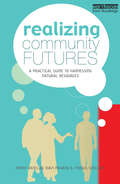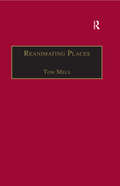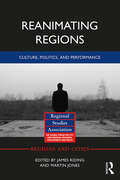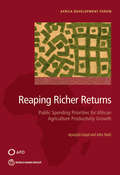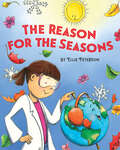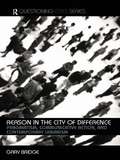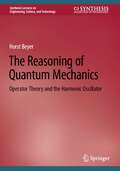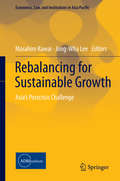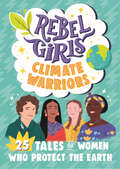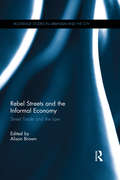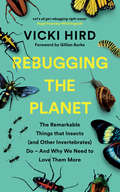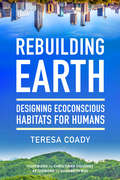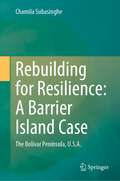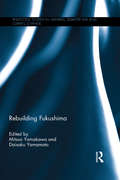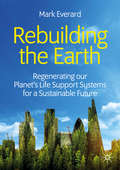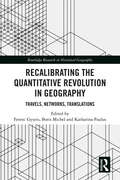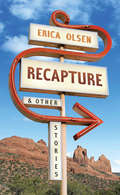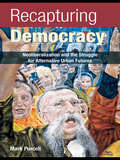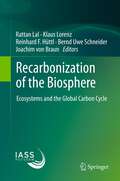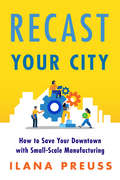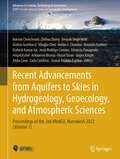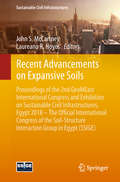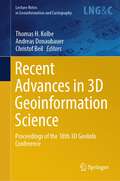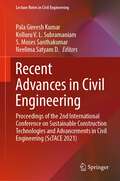- Table View
- List View
Realizing Community Futures: A Practical Guide to Harnessing Natural Resources
by Ravi Prabhu Fergus Sinclair Jerry VanclayThis revolutionary book is a practical guide for helping communities in any location or context - from a fishing community in England to a logging town in Canada to a farming village in India - to develop a collective vision of a prosperous and sustainable future and a road-map for mobilizing and managing their natural resources to realize that future. It explains in a step-by-step manner how to use a process of 'participatory modelling' to structure people's learning, their understanding of the natural systems they depend upon and how this can lead to better social and environmental outcomes. The book is for communities and professional natural resources managers who want to use this powerful tool to help people share visions of the future they want and to take appropriate, immediate action to turn them into reality. It introduces both the theory and practice of participatory modelling using everyday language and a variety of accessible and successful examples. The result is a practical, useful and accessible guide for practicing real, successful community-based natural resource management anywhere, in any circumstances, for community prosperity.
Reanimating Places: A Geography of Rhythms (Re-materialising Cultural Geography)
by Tom MelsTime-space relationships are central to human geography. This book seeks to reanimate time-space, by considering the links between lived experience, various temporalities and particular places in terms of compounded and contested rhythms. Time-space rhythms emphasize the practical, symbolic, everyday and embodied qualities in the experience and making of our geographical environment. Bringing together a team of renowned geographers who have been exploring such ideas over the past decades, this book provides a unique and varied set of geographical approximations to the reanimation of place, nature and landscape, revealing a complex, disputed world of politics, sensory experiences and representations of space-time. Including case studies from Europe and North America, the book addresses some important issues, ranging from the symbolic orchestrations of landscape to deeply personal memories of particular natural rhythms.
Reanimating Regions: Culture, Politics, and Performance (Regions and Cities)
by James Riding Martin JonesWriting regions, undertaking a regional study, was once a standard form of geographic communication and critique. This was until the quantitative revolution in the middle of the previous century and more definitively the critical turn in human geography towards the end of the twentieth century. From then on writing regions as they were experienced phenomenologically, or arguing culturally, historically, and politically with regions, was deemed to be old-fashioned. Yet the region is, and always will be, a central geographical concept, and thinking about regions can tell us a lot about the history of the discipline called geography. Despite taking up an identifiable place within the geographical imagination in scholarship and beyond, region remains a relatively forgotten, under-used, and in part under-theorised term. Reanimating Regions marks the continued reinvigoration of a set of disciplinary debates surrounding regions, the regional, and regional geography. Across 18 chapters from international, interdisciplinary scholars, this book writes and performs region as a temporary permanence, something held stable, not fixed and absolute, at different points in time, for different purposes. There is, as this expansive volume outlines, no single reading of a region. Reanimating Regions collectively rebalances the region within geography and geographical thought. In renewing the geography of regions as not only a site of investigation but also as an analytical framework through which to write the world, what emerges is a powerful reworking of the geographic imagination. Read against one another, the chapters weave together timely commentaries on region and regions across the globe, with a particular emphasis upon the regional as played out in the United Kingdom, and regional worlds both within and beyond Europe, offering chapters from Africa and South America. Addressing both the political and the cultural, this volume responds to the need for a consolidated and considered reflection on region, the regional, and regional geography, speaking directly to broader intellectual concerns with performance, aesthetics, identity, mobilities, the environment, and the body.
Reaping Richer Returns: Public Spending Priorities for African Agriculture Productivity Growth
by Aparajita Goyal John NashEnhancing the productivity of agriculture is vital for Sub-Saharan Africa's economic future and is one of the most important tools to end extreme poverty and boost shared prosperity in the region. How governments elect to spend public resources has significant development impact in this regard. Choosing to catalyze a shift toward more effective, efficient, and climate-resilient public spending in agriculture can accelerate change and unleash growth. Not only does agricultural public spending in Sub-Saharan Africa lag behind other developing regions but its impact is vitiated by subsidy programs and transfers that tend to benefit elites to the detriment of poor people and the agricultural sector itself. Shortcomings in the budgeting processes also reduce spending effectiveness. In light of this scenario, addressing the quality of public spending and the efficiency of resource use becomes even more important than addressing only the level of spending. Improvements in the policy environment, better institutions, and investments in rural public goods positively affect agricultural productivity. These, combined with smarter use of public funds, have helped lay the foundations for agricultural productivity growth around the world, resulting in a wealth of important lessons from which African policy makers and development practitioners can draw. 'Reaping Richer Returns: Public Spending Priorities for African Agriculture Productivity Growth' will be of particular interest to policy makers, development practitioners, and academics. The rigorous analysis presented in this book provides options for reform with a view to boosting the productivity of African agriculture and eventually increasing development impact.
The Reason for the Seasons
by Ellie PetersonWe all know there are four seasons in a year. But HOW do we know? Join intrepid young scientist-adventurer Joulia Copernicus on a journey around the world as she explains with humor and wit how we know what causes the seasons.Winter, spring, summer, fall -- we all have a favorite season. But what makes the seasons happen in the first place? Ellie Peterson's clear, concise language and bold, kid-friendly illustrations bring science to life through narrator Joulia Copernicus, a strong and adventurous kid scientist. Kids will laugh while learning at the same time about the science behind the changing of the seasons throughout the year.
Reason in the City of Difference (Questioning Cities)
by Gary BridgeIn the modernist city rationality ruled and subsumed difference in a logic of identity. In the postmodern city, reason is abandoned for an endless play of difference. Reason in the City of Difference poses an alternative to these extremes by drawing on classical American philosophical pragmatism (and its contemporary developments in feminism and the philosophy of communication) to explore the possibilities of a strengthening and deepening of reason in the contemporary city. This is a transactional rationality based on communication, rather than cognition, involving bodies as much as minds, and non-discursive, as well as discursive competences. It is a rationality that emerges out of difference and from within the city, rather than over and above it. Using pragmatist philosophy and a range of suggestive examples of urban scholarship, this fascinating book offers a new, alternative reading of the city.
The Reasoning of Quantum Mechanics: Operator Theory and the Harmonic Oscillator (Synthesis Lectures on Engineering, Science, and Technology)
by Horst BeyerThis book presents and details the process of quantization of a classical mechanical system in a relevant physical system, the harmonic oscillator. In quantum field theory or general relativity, mathematics and physics are inextricably interwoven. As such, the book is mathematically rigorous. The author focuses on the properties of the quantum system that can be observed and measured and interprets the resulting theory. The methods of operator theory are discussed throughout in the formulation of the theory as well as in the calculation of the consequences of the theory. The book addresses the mathematical support of the probabilistic interpretation of quantum mechanics through the spectral theorems for (densely-defined and linear) self-adjoint operators in Hilbert spaces. Considerable focus is placed on the measurement process and questions the challenges of the wave function, the EPR paradox, and Bell’s inequality.
Rebalancing for Sustainable Growth
by Masahiro Kawai Jong-Wha LeeThe Asian model of export-led growth served it well in the post-war period, but prolonged sluggish growth of the developed economies following the global financial crisis, together with growing inequality and rising environmental problems, point to the need for a new growth model. The purpose of this book is to describe the challenges facing Asian economies in the post-global financial crisis environment and to identify structural issues and policies that can help guide Asian policymakers to expand the growth potential of domestic and regional demand in coming years, and thereby create a basis for balanced, sustainable, and inclusive long-term growth. These issues and policies span a variety of dimensions, including macroeconomic policy (monetary, fiscal, and foreign currency management), real sector issues (trade and industrial structure), infrastructure development, labor market and social policy, financial sector reform and regulation, and regional cooperation and architecture. Key recommendations to achieve these goals include measures to: deepen social protection to support social resilience; increase infrastructure investment to create a "seamless Asia"; enhance productivity in the services sector; establish a region-wide free trade agreement to encourage intraregional trade in goods and services and investment through economies of scale and dynamic efficiency of a larger market; promote a shift to a low-carbon society and support green growth; and deepen and integrate financial markets to facilitate the recycling of Asia's high savings for investment within the region.
Rebel Girls Climate Warriors: 25 Tales of Women Who Protect the Earth (Rebel Girls Minis)
by Rebel Girls Cristina MittermeierA COMMON SENSE SELECTION (Common Sense Media)With fairytale-like stories about Greta Thunberg, Autumn Peltier, and Rachel Carson, Rebel Girls Climate Warriors: 25 Tales of Environmental Allies spotlights the world-changing work of women on the frontlines of the fight for climate justice.Meet conservationists, activists, water protectors, philanthropists, authors, and other women from all over the world who have stood up to polluters and used their amazing talents to protect the planet.Rebel Girls Climate Warriors is part of the award-winning Good Night Stories for Rebel Girls series.It is illustrated by female and nonbinary artists from around the world.Join Greta Thunberg for a climate strike. Plant a tree with Wangari Maathai. Stand with water protector Autumn Peltier. And turn trash into profits and independence with Isatou Ceesay. Rebel Girls Climate Warriors tells the stories of the ingenuity and commitment of these women and more, including Canadian novelist Margaret Atwood, Nigerian activist Esohe Ozigbo, Indigenous Ecuadorian leader Nemonte Nenquimo, and Thai landscape architect Kotchakorn Voraakhom.Unlock bonus audio stories of some of the extraordinary women and girls featured in this book on the Rebel Girls app. Whenever you come across a bookmark icon on the page, scan the QR code, and you&’ll be whisked away on an audio adventure! You&’ll also discover 100+ creative activities and stories of even more trailblazing women on the app.
Rebel Streets and the Informal Economy: Street Trade and the Law (Routledge Studies in Urbanism and the City)
by Alison BrownStreet trade is a critical and highly visible component of the informal economy, linked to global systems of exchange. Yet policy responses are dismissive and evictions commonplace. Despite being progressively marginalised from public space, street traders in the global south are engaged in spatial and political battlegrounds to reclaim space, and claim de facto property rights over their place of work, through quiet infiltration, union power, or direct action. This book explores 'rebel streets', the challenges faced by informal economy actors and how organised groups are seeking to reframe legal understandings to create new claims to space and urban rights. The book sets out new thinking and a conceptual framework for improved understanding of the plural relationship between law, rights, and space for the informal economy, the contest between traditional, modernist and rights-based approaches to development, and impacts on the urban working poor. With a focus on street trading, the book seeks to reframe the legal context in which modern informal economies operate, drawing on key areas of academic inquiry and case studies of how vendors are staking claim to urban rights. The book argues for a reconceptualisation of legal instruments to provide a rights-based framework for urban work that recognises the legitimacy of urban informal economies, the scope for collective management of urban resources, and the social value of public space as a site for urban livelihoods. It will be of interest to students and scholars of geography, economics, urban studies, development studies, political studies and law.
Rebugging the Planet: The Remarkable Things that Insects (and Other Invertebrates) Do – And Why We Need to Love Them More
by Vicki Hird"This is a lovely little book that could and should have a big impact...Let’s all get rebugging right away!"—Hugh Fearnley-Whittingstall Meet the intelligent insects, marvelous minibeasts, and inspirational invertebrates that help shape our planet—and discover how you can help them help us by rebugging your attitude today! Remember when there were bugs on your windshield? Ever wonder where they went? We need to act now if we are to help the insects survive. Robin Wall Kimmerer, David Attenborough, and Elizabeth Kolbert are but a few voices championing the rewilding of our world. Rebugging the Planet explains how we are headed toward “insectageddon” with a rate of insect extinction eight times faster than that of mammals or birds, and gives us crucial information to help all those essential creepy-crawlies flourish once more. Author Vicki Hird passionately demonstrates how insects and invertebrates are the cornerstone of our global ecosystem. They pollinate plants, feed birds, support and defend our food crops, and clean our water systems. They are also beautiful, inventive, and economically invaluable—bees, for example, contribute an estimated $235 to $577 billion to the US economy annually, according to Forbes. Rebugging the Planet shows us small changes we can make to have a big impact on our littlest allies: Learn how to rewild parks, schools, sidewalks, roadsides, and other green spaces. Leave your garden to grow a little wild and plant weedkiller-free, wildlife-friendly plants. Take your kids on a minibeast treasure hunt and learn how to build bug palaces. Make bug-friendly choices with your food and support good farming practices Begin to understand how reducing inequality and poverty will help nature and wildlife too—it’s all connected. So do your part and start rebugging today! The bees, ants, earthworms, butterflies, beetles, grasshoppers, ladybugs, snails, and slugs will thank you—and our planet will thank you too.
Rebuilding Asia Following Natural Disasters
by Daly, Patrick and Feener, R. Michael Patrick Daly R. Michael FeenerProviding a detailed and comparative assessment of the humanitarian responses to a series of major disasters in Asia over the past two decades, including massive earthquakes, volcanic eruptions, and tsunamis, this book explores complex and changing understandings and practices of relief, recovery, and reconstruction. These critical investigations raise questions about the position and responsibilities of a growing range of stakeholders, and provide in-depth explorations of the ways in which local communities are transformed on multiple levels - not only by the impact of disaster events, but also by the experiences of rebuilding. This timely volume highlights how the experiences of Asia can contribute towards post-disaster responses globally, to safeguard future communities and reduce vulnerabilities. This is a valuable resource for academic researchers interested in post-disaster transformations and development studies, practitioners in NGOs, and government officials dealing with disaster response and disaster risk reduction.
Rebuilding Earth: Designing Ecoconscious Habitats for Humans
by Teresa CoadyA revolutionary guide to designing humane, eco-conscious homes, buildings, and cities of the future.It is estimated that the earth's population will expand to an unprecedented nine billion people over the next century. This explosion in population is predicted to place further stress on our environment, deplete our natural resources, and lead to increases in anxiety and depression due to overcrowding. In this visionary and uplifting book, Teresa Coady offers readers new hope. Rebuilding Earth is her blueprint for designing and building the cities, buildings, and homes of tomorrow, resulting in more conscious, sustainable, and humane living. Coady shows us how we can shift from an outdated Industrial-Age framework to a more humane, Digital-Age framework. This revolutionary approach will enable communities to harness various forms of green energy and reduce the amount of material needed to build infrastructure while contributing to a healthier planet (and society). We can then experience a new sense of purpose, health, and happiness. Meaningful and lasting change, the author tells us, can only come through designing interconnected communities that are vibrant, resilient, and communal. Unlike most predictions of doom and gloom, Coady presents a refreshingly optimistic view of humanity and its future. This book will appeal to those in the construction, design and development finance industries, as well as anyone interested in improving their lives through understanding the connections between the environment and health.
Rebuilding for Resilience: The Bolivar Peninsula, U.S.A.
by Chamila SubasingheRecurring extreme events of nature challenge disaster-prone settlements in complex ways. Devastating property damages are one of the tests of survival for such settlements in both economic and social terms. It also provides unique opportunities to rethink the environment cleared by massive natural disasters. However, rebuilding for long-term resiliency is one of the least investigated areas, particularly when employing tacit knowledge in the sustainable recovery process. This book builds a discursive field around the post-disaster rebuilding of Bolivar Peninsula aftermath Hurricane Ike to demonstrate reciprocity between disaster absorptive ecological formations such as barrier islands and their exploitative human occupation. In the process, it investigates the nexus between connectivity among open space networks to various levels of surge damage among Bolivar spontaneous settlements. Beyond scientific analyses, the Hurricane Ike study triangulates syntactical methods with structured observations and statistical analyses to offer a holistic reporting model for emerging scholars and independent investigators, which one may find quite absent in the mainstream disaster studies and journalism.
Rebuilding Fukushima (Routledge Studies in Hazards, Disaster Risk and Climate Change)
by Mitsuo Yamakawa and Daisaku YamamotoFive years after the one of the worst nuclear accidents in history, Fukushima now only occasionally headlines national and international media. However, the disaster is far from over, as evidenced by a hundred thousand people from Fukushima still in the state of evacuation, rising levels of radiation in streams and rivers, and failing attempts to control the leakage of radioactive materials at the Fukushima Daiichi Nuclear Power Plant. Despite these dismal conditions, efforts to recover and rebuild livelihoods in the afflicted regions of Fukushima did start immediately after the outset of the accident. Rebuilding Fukushima gives an account of how citizens, local governments, and businesses responded to and coped with the crisis of Fukushima. It addresses principles to guide reconstruction and international policy environments in which the current disaster is situated. It explores how reconstruction is articulated and experienced at different spatial scales, ranging from individuals to communities and municipalities, and details recovery efforts, achievements, and challenges in the realms of public transportation, agriculture and food production, manufacturing industries, retail sectors, and renewable-energy industries. This book also critically investigates the nature of the current reconstruction policy schemes, and seeks to articulate what may be required in order to achieve more sustainable and equitable (re)development in afflicted regions and other nuclear host regions. Drawing on extensive fieldwork and local surveys, this volume is one of the first books in English that captures the knowledge and insights of native Japanese social scientists who dealt with the complexities of nuclear disaster on a day-to-day basis. It will be of great interest to students and scholars of disaster-management studies and nuclear policy.
Rebuilding the Earth: Regenerating our planet’s life support systems for a sustainable future
by Mark EverardRebuilding the Earth highlights humanity’s interdependence with the planet’s ecosystems. Today, these ecosystems are seriously degraded, compromising future security and opportunity. It is essential that we set about rebuilding the metaphorical ‘ark’ of nature upon which our future prospects depend. Central to this book are several case studies of regenerative approaches drawn from every continent on the planet. These approaches are founded on restoration and protection of ecosystems – water and soil, forests, marine and coastal resources, urban infrastructure, farming practices and in corporate supply chains. Rebuilding the Earth is above all optimistic about the daunting challenges facing global society. It is about culture change, addressing the necessity of and the means for putting nature and people back into the heart of societal thinking, policy and action. It advocates for sustainable development in its deepest green sense, but also pragmatically framed in social, technological, governance and economic contexts. The concluding message is “Yes, we can!”
Recalibrating the Quantitative Revolution in Geography: Travels, Networks, Translations (Routledge Research in Historical Geography)
by Ferenc Gyuris Boris Michel Katharina PaulusThis book brings together international research on the quantitative revolution in geography. It offers perspectives from a wide range of contexts and national traditions that decenter the Anglo-centric discussions. The mid-20th century quantitative revolution is frequently regarded as a decisive moment in the history of geography, transforming it into a modern and applied spatial science. This book highlights the different temporalities and spatialities of local geographies laying the ground for a global history of a specific mode of geographical thought. It contributes to the contemporary discussions around the geographies and mobilities of knowledge, notions of worlding, linguistic privilege, decolonizing and internationalizing of geographic knowledge. This book will be of interest to researchers, postgraduates and advance students in geography and those interested in the spatial sciences.
Recapture
by Erica OlsenThe Utah Canyons WildMall gives tourists exactly what they want. An archivist preserves a rare map of a vanished Lake Tahoe. The Grand Canyon can only be visited in replica form. These stories-lyrical, deadpan, surreal-blur the line between the natural world and the world we make.Praise for Recapture:A Library Journal Best Short Story Collection of the Year"Unsentimental stories that tell us what the American West looks like now and what we've lost; the Grand Canyon, for instance, can be seen only in replica after environmental catastrophe."-Barbara Hoffert, Library Journal"Recapture is a living, breathing museum of natural wonders. With writing as spare as the landscape she evokes, Olsen wades through the detritus of the human experience and finds clarity there, and some magic, too."-ZYZZYVA"True to its name, Recapture grasps after lost loves, fading histories, and shifting landscapes to bring us an expertly curated series of human exhibits in an expansive, outdoor museum."-Lindsey Griffin, the museum of americana literary review"Erica Olsen gives us the dream life of the Southwest in this striking collection, a landscape told in language as spare and pungent and exacting as the desert itself. A swift and lovely debut from a writer of real gifts."-Kevin Canty, author of Where the Money Went"These sly, heartbreaking stories capture the modern West, where the past is ever-present and the future is already here."-Alison Baker, author of How I Came West, and Why I Stayed"Beneath their polished surfaces, Erica Olsen's stories are subversive, sometimes darkly funny, and always disquieting. When you set off on a hike in her universe, be prepared for surprises. You may find yourself exploring Utah-or Norway-or a surreal faux wilderness where rainbows are regularly scheduled and gnats are outlawed. Also, prepare to be exhilarated. This accomplished writer really knows her way through the tricky zone between truth and falsehood where art is made."-Susan Lowell Humphreys, author of Ganado Red"A sharp, wise new voice from the American West, Erica Olsen is the real thing. As wild as David Foster Wallace or George Saunders and as tender as James Salter or Alice Munro, Olsen's stories are hilarious, painful, and achingly lovely."-Amanda Eyre Ward, author of Close Your Eyes"Like all good narratives, Erica Olsen's "Grand Canyon II" suggests great consequence. The past is another country. The task of memory is impossible. No one exists and nothing ever happened. But somewhere in your brain, a beautiful lie is being spun..."-Sarah Manguso, author of The Guardians"Recapture is like a lost map of the backcountry, detailing the forgotten places where secrets shove up through the dust, pieces of lives demanding to be made whole. The territory is endlessly illuminating and constantly surprising, revealing a master storyteller at work."-Kim Todd, author of Tinkering with Eden: A Natural History of Exotic Species in America
Recapturing Democracy: Neoliberalization and the Struggle for Alternative Urban Futures
by Mark PurcellRecapturing Democracy is a short yet synoptic introduction to urban democracy in our era of political neoliberalism and economic globalization. Combining an original argument with a number of case studies, Mark Purcell explores the condition of democracy in contemporary Western cities. Whereas many scholars focus on what Purcell calls "procedural democracy" – i.e., electoral politics and access to it – he instead assesses "substantive democracy." By this he means the people’s ability to have some say over issues of social justice, material well being, and economic equality. Neoliberalism, which advocates a diminished role for the state and increasing power for mobile capital, has diminished substantive democracy in recent times, he argues. He looks at case studies where this has occurred and at others that show how neoliberalism can be resisted in the name of substantive democracy. Ultimately, he utilizes Henri Lefebvre’s notion of "the right to the city," which encompasses substantive as well as procedural democracy for ordinary urban citizens.
Recarbonization of the Biosphere
by Joachim Von Braun Rattan Lal Bernd Uwe Schneider Klaus Lorenz Reinhard F. HüttlHuman activities are significantly modifying the natural global carbon (C) cycles, and concomitantly influence climate, ecosystems, and state and function of the Earth system. Ever increasing amounts of carbon dioxide (CO2) are added to the atmosphere by fossil fuel combustion but the biosphere is a potential C sink. Thus, a comprehensive understanding of C cycling in the biosphere is crucial for identifying and managing biospheric C sinks. Ecosystems with large C stocks which must be protected and sustainably managed are wetlands, peatlands, tropical rainforests, tropical savannas, grasslands, degraded/desertified lands, agricultural lands, and urban lands. However, land-based sinks require long-term management and a protection strategy because C stocks grow with a progressive improvement in ecosystem health.
Recast Your City: How to Save Your Downtown with Small-Scale Manufacturing
by Ilana PreussIn Recast Your City: How to Save Your Downtown with Small-Scale Manufacturing, community development expert Ilana Preuss explains how local leaders can revitalize their downtowns or neighborhood main streets by bringing in and supporting small-scale manufacturing. Small-scale manufacturing businesses help create thriving places, with local business ownership opportunities and well-paying jobs that other business types can't fulfill.Preuss draws from her experience working with local governments, large and small, from Knoxville, Tennessee, to Columbia, Missouri, to Fremont, California. She provides tools, such as her five-step method for recasting your city, that local leaders in government, business, and real estate as well as entrepreneurs and advocates in every community can use.
Recent Advancements from Aquifers to Skies in Hydrogeology, Geoecology, and Atmospheric Sciences: Proceedings of the 2nd MedGU, Marrakesh 2022 (Volume 1) (Advances in Science, Technology & Innovation)
by Haroun Chenchouni Zhihua Zhang Deepak Singh Bisht Matteo Gentilucci Mingjie Chen Helder I. Chaminé Maurizio Barbieri Mahesh Kumar Jat Jesús Rodrigo-Comino Dionysia Panagoulia Amjad Kallel Arkoprovo Biswas Veysel Turan Jasper Knight Attila Çiner Carla Candeias Zeynal Abiddin ErgülerThis book is based on the accepted papers for presentation at the 2nd MedGU Annual Meeting, Marrakesh 2022. It presents a series of newest research studies that are nowadays relevant mainly to Middle East, Mediterranean region, and Africa. It includes major subjects related to hydrology, hydrogeology, hydrogeochemistry including, but not limited to, isotope hydrology, groundwater models, water resources and systems, and related subjects. It also includes research studies on biogeochemistry which mainly focus on the interactions between life and the chemical cycles in the Earth system. Some case studies on geobiology and geoecology investigate the structure and function of geoecosystems, their components, and their environment. The book also presents major subjects related to atmospheric, oceanic, meteorology and climatic science with recent developments in the field. By cutting across these traditional subject boundaries, this book brings together the major elements that are important for understanding the weather, climate, water systems, and geoecosystems in these regions.
Recent Advancements on Expansive Soils: Proceedings Of The 2nd Geomeast International Congress And Exhibition On Sustainable Civil Infrastructures, Egypt 2018 - The Official International Congress Of The Soil-structure Interaction Group In Egypt (ssige) (Sustainable Civil Infrastructures)
by John S. McCartney Laureano R. HoyosThis volume includes a collection of technical papers on an important topic in geotechnical engineering; the behavior and treatment of expansive soils. The research studies include investigations into novel stabilization techniques for expansive soils using different admixtures or mechanical consolidation techniques, as well as new experimental approaches to evaluate the behavior of expansive soils. They also include an evaluation of wetting boundary conditions on the volume change of expansive soils, as well as the role of hydrologic boundary conditions in arid climates. The volume is based on the best contributions to the 2nd GeoMEast International Congress and Exhibition on Sustainable Civil Infrastructures, Egypt 2018 – The official international congress of the Soil-Structure Interaction Group in Egypt (SSIGE).
Recent Advances in 3D Geoinformation Science: Proceedings of the 18th 3D GeoInfo Conference (Lecture Notes in Geoinformation and Cartography)
by Thomas H. Kolbe Andreas Donaubauer Christof BeilThe book includes the contributions to the international conference “18th 3D GeoInfo”. The papers published in the book were selected through a double-blind review process. 3D GeoInfo has been the forum joining researchers, professionals, software developers, and data providers designing and developing innovative concepts, tools, and application related to 3D geo data processing, modeling, management, analytics, and simulation. A big focus is on topics related to data modeling for 3D city and landscape models as well as their many and diverse applications. This conference series is very successfully running since 2006 and has been hosted by countries in Europe, Asia, Africa, North America, and Australia. In the period 2006 to 2017, the proceedings has been published by Springer in this series with Thomas H. Kolbe being the editor of the 2010 edition of the conference proceedings. 18th 3DGeoInfo was organized by Technical University of Munich in cooperation with the German Society for Photogrammetry, Remote Sensing and Geoinformation (DGPF), the local associations Runder Tisch GIS e.V. (Round Table GIS) and Leonhard Obermeyer Center—TUM Center of Digital Methods for the Built Environment, and the City of Munich. The international program committee consisted of committee members of previous 3D GeoInfo conferences and further leading scientists in the field of 3D Geoinformation Science.
Recent Advances in Civil Engineering: Proceedings of the 2nd International Conference on Sustainable Construction Technologies and Advancements in Civil Engineering (ScTACE 2021) (Lecture Notes in Civil Engineering #233)
by Pala Gireesh Kumar Kolluru V. L. Subramaniam Moses Santhakumar M. Neelima Satyam D.The book presents the select proceedings of the 2nd International Conference on Sustainable Construction Technologies and Advancements in Civil Engineering (ScTACE 2021). This book discusses the latest developments and contributions towards sustainable construction technologies and advances in civil engineering. Various topics covered in this book are construction technologies, geotechnical engineering, transportation and traffic engineering, structural engineering, environmental engineering, remote sensing and GIS, geo-environmental engineering, water resources engineering and earthquake engineering. This book will be useful for students, researchers and professionals working in the area of civil engineering.
